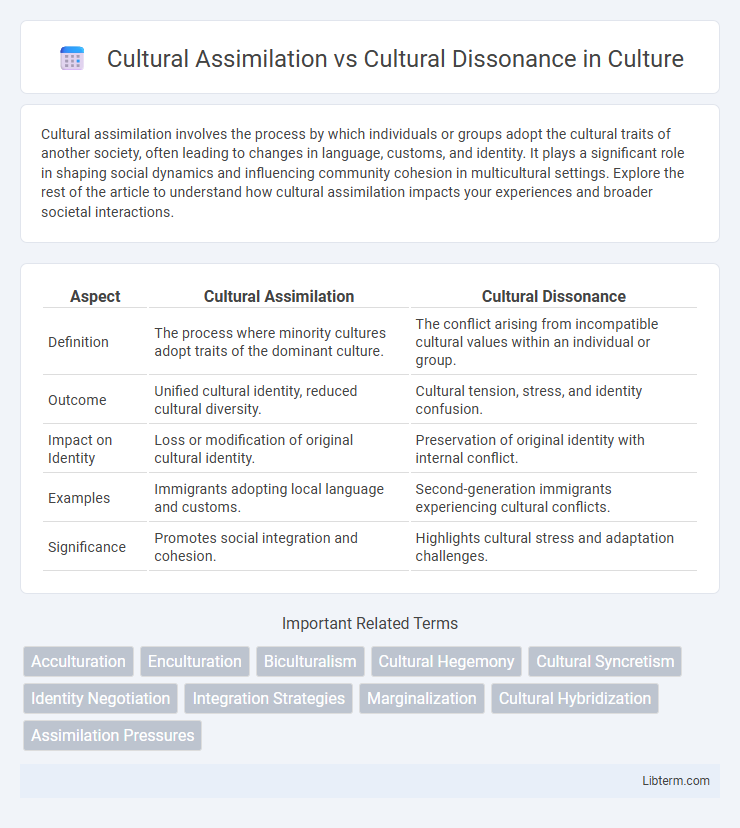Cultural assimilation involves the process by which individuals or groups adopt the cultural traits of another society, often leading to changes in language, customs, and identity. It plays a significant role in shaping social dynamics and influencing community cohesion in multicultural settings. Explore the rest of the article to understand how cultural assimilation impacts your experiences and broader societal interactions.
Table of Comparison
| Aspect | Cultural Assimilation | Cultural Dissonance |
|---|---|---|
| Definition | The process where minority cultures adopt traits of the dominant culture. | The conflict arising from incompatible cultural values within an individual or group. |
| Outcome | Unified cultural identity, reduced cultural diversity. | Cultural tension, stress, and identity confusion. |
| Impact on Identity | Loss or modification of original cultural identity. | Preservation of original identity with internal conflict. |
| Examples | Immigrants adopting local language and customs. | Second-generation immigrants experiencing cultural conflicts. |
| Significance | Promotes social integration and cohesion. | Highlights cultural stress and adaptation challenges. |
Understanding Cultural Assimilation
Cultural assimilation refers to the process by which individuals or groups adopt the cultural traits, values, norms, and behaviors of another dominant culture, often leading to a loss of original cultural identity. This phenomenon is commonly observed in immigrant populations integrating into new societies, where language acquisition, social customs, and economic participation play crucial roles in assimilation outcomes. Understanding cultural assimilation involves analyzing factors like social pressure, policy frameworks, and the balance between maintaining heritage and embracing new cultural practices.
Defining Cultural Dissonance
Cultural dissonance occurs when individuals experience psychological discomfort or confusion due to conflicting cultural values, beliefs, or practices between their native culture and a new or dominant culture. This phenomenon often leads to identity struggles and challenges in social integration as individuals navigate incompatible cultural expectations. Understanding cultural dissonance is crucial for addressing issues related to multiculturalism, immigration, and social cohesion in diverse societies.
Historical Perspectives on Assimilation and Dissonance
Historical perspectives on cultural assimilation reveal patterns of dominant societies imposing their norms on minority groups, often through policies such as forced education and language suppression. Cultural dissonance emerges as resistance to these pressures, manifesting in the preservation of native traditions and identities despite external demands. Key examples include the assimilation strategies during colonial expansions and the resulting social tensions that highlight the persistent struggle between cultural conformity and preservation.
Key Differences Between Assimilation and Dissonance
Cultural assimilation involves the process where individuals or groups adopt the norms, values, and behaviors of another culture, leading to diminished distinct cultural identities. In contrast, cultural dissonance arises from conflicting cultural beliefs and practices within individuals or communities, causing psychological stress and social tension. The key difference lies in assimilation promoting cultural integration and uniformity, while dissonance highlights cultural conflict and fragmentation.
Factors Influencing Cultural Assimilation
Factors influencing cultural assimilation include language proficiency, social integration opportunities, and the degree of cultural similarity between the migrant and host societies. Economic stability and educational access also play critical roles in facilitating assimilation by providing resources and environments that support cultural adaptation. Furthermore, individual attitudes toward cultural identity and the openness of the host community significantly affect the assimilation process.
The Impact of Cultural Dissonance on Identity
Cultural dissonance profoundly affects identity by creating internal conflict and feelings of alienation when an individual's native cultural values clash with those of a dominant society. This psychological tension can lead to identity fragmentation, decreased self-esteem, and difficulties in social integration. The ongoing struggle to reconcile conflicting cultural norms often results in a complex, hybrid identity marked by uncertainty and cultural ambiguity.
Social and Psychological Effects
Cultural assimilation can lead to social integration and enhanced opportunities but may cause identity loss and psychological stress due to pressure to conform. Cultural dissonance often results in social isolation and heightened anxiety as individuals struggle with conflicting cultural values and expectations. Both phenomena profoundly impact mental health, influencing self-esteem, sense of belonging, and interpersonal relationships within multicultural settings.
Case Studies: Real-world Examples
Case studies of cultural assimilation reveal how immigrant communities in the United States, such as the Cuban exiles in Miami, adopt mainstream cultural norms while preserving distinct traditions, fostering social cohesion. In contrast, cultural dissonance is evident in the experience of Native American populations, where conflicting values between indigenous practices and dominant societal expectations lead to identity struggles and social marginalization. Research on South Asian diaspora in the UK highlights the tension between cultural preservation and adaptation, illustrating the complex negotiation of identity in multicultural environments.
Navigating Cultural Conflict and Acceptance
Navigating cultural conflict involves understanding the dynamics between cultural assimilation, where individuals adopt the dominant culture's norms, and cultural dissonance, which arises from the tension between differing cultural values. Effective strategies for fostering cultural acceptance emphasize respectful dialogue, empathy, and openness to diverse perspectives, allowing communities to reconcile differences without erasing unique identities. This approach helps reduce cultural clashes and promotes social cohesion through mutual recognition and adaptation.
Future Trends in Multicultural Societies
Future trends in multicultural societies reveal a growing tension between cultural assimilation and cultural dissonance, influenced by globalization and increased migration. Digital communication platforms accelerate cultural exchange, yet also intensify identity conflicts as individuals navigate preserving heritage while integrating new norms. Policymakers and social institutions must address these dynamics by promoting inclusive frameworks that respect diversity while fostering social cohesion.
Cultural Assimilation Infographic

 libterm.com
libterm.com